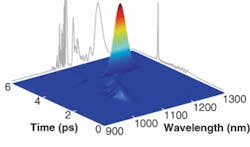Once thought to be mythical, giant waves on the open ocean that could swallow entire ships before vanishing without a trace were finally recorded for the first time at the Draupner oil platform in the North Sea.1 Now, for the very first time, such “rogue waves” have been predicted and captured in an optical system by scientists at the University of California at Los Angeles (UCLA).2
Although they are rare, rogue waves (which have also been seen with satellite imagery) appear in the ocean much more frequently than predicted by conventional Gaussian or Rayleigh wave-amplitude statistics. Motivated by this discrepancy, scientists have attempted to explain their existence with alternative mechanisms. Nonlinear models have attracted considerable interest because they are capable of generating extreme events more frequently than intuitively expected. Furthermore, the unusually steep and solitary profiles of rogue waves suggest a connection to solitons—broadband, solitary waves that can propagate without spreading because of a balance between dispersion and nonlinearity.
Oddly enough, the scientists at UCLA were able to draw a comparison between the physical attributes of rogue waves in the ocean and the physics of supercontinuum generation within nonlinear optical fibers. By launching intense seed pulses into a nonlinear microstructured optical fiber at or near its zero-dispersion wavelength, a broadband supercontinuum source can be created. The supercontinuum is comprised of solitons that shift toward the red as they propagate through the fiber. Modulation instabilities within the fiber cause the output spectrum to be extremely sensitive to the initial conditions of the pulse, which amplifies the input noise.
In the experimental setup, a wavelength-to-time transformation technique (inspired by the concept of photonic time-stretch analog-to-digital conversion) uses group velocity dispersion to stretch the waves temporally so that thousands of random ultrashort events can be captured in real time. Picosecond seed pulses from a 1064 nm laser are sent through a length of highly nonlinear microstructured optical fiber with matched zero-dispersion wavelength. The output is red-pass filtered at 1450 nm and stretched using the wavelength-to-time technique. The setup allows the capture of large sets of pulses in real time at very low seed-pulse power levels—below the threshold required to produce a supercontinuum. While most of the captured events are buried beneath the noise floor of the measurement setup, some extreme events have intensities of 30 to 40 times the average. These waves have broad bandwidths and steep profiles—characteristics that have also been attributed to oceanic rogue waves. Event histograms show an L-shaped profile, with extreme waves occurring rarely, yet much more frequently than expected.
In addition to measured results, the scientists used the nonlinear Schrödinger equation (NLSE) to model the wave dynamics and predict the observed behavior. The NLSE analysis shows that when a tiny perturbation (noise) is added to the optical system, nonlinear instabilities can create unpredictable, freak events—optical rogue waves (see figure).
By analyzing the temporal and spectral properties of the initial conditions of the noise, the scientists found that if it contains energy with a frequency shift of about 8 THz within a 0.5 ps window centered about 1.4 ps before the pulse peak, a rogue-wave event occurs. Simulations also show that the optical rogue waves survive for an unpredictable amount of time before they suddenly collapse. “Optical rogue waves bear a close connection to their oceanic cousins,” says Daniel Solli, the researcher who led the investigation. “Optical experiments may help to resolve the mystery of oceanic rogue waves, which are very difficult to study directly.”
REFERENCES
1. W.J. Broad, “Rogue giants at sea,” The New York Times (July 11, 2006).
2. D.R. Solli et al., Nature 450, 1054 (Dec. 13, 2007).
About the Author

Gail Overton
Senior Editor (2004-2020)
Gail has more than 30 years of engineering, marketing, product management, and editorial experience in the photonics and optical communications industry. Before joining the staff at Laser Focus World in 2004, she held many product management and product marketing roles in the fiber-optics industry, most notably at Hughes (El Segundo, CA), GTE Labs (Waltham, MA), Corning (Corning, NY), Photon Kinetics (Beaverton, OR), and Newport Corporation (Irvine, CA). During her marketing career, Gail published articles in WDM Solutions and Sensors magazine and traveled internationally to conduct product and sales training. Gail received her BS degree in physics, with an emphasis in optics, from San Diego State University in San Diego, CA in May 1986.
